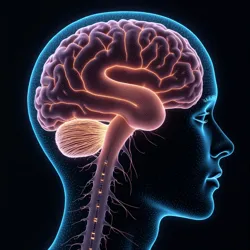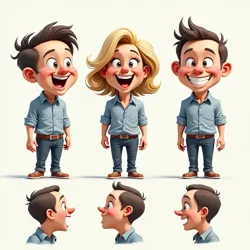Humor Signatures
 A neural visualization showing the distinct pattern of an individual's humor signature, with characteristic peaks in conceptual irony and temporal layering (2163)
A neural visualization showing the distinct pattern of an individual's humor signature, with characteristic peaks in conceptual irony and temporal layering (2163)Humor signatures represent one of the most fascinating developments in post-linguistic social interaction, emerging as unique identifiers of individual comedic expression in the era following the Great Silence. These distinctive neural patterns, which develop naturally through an individual's lifetime of humor experiences and preferences, serve as sophisticated markers of personality and social identity in contemporary society. The phenomenon has transformed how humans recognize and relate to one another in the age of direct neural interfaces.
Development and Formation
Humor signatures begin forming in early childhood, as individuals first interact with neural entertainment networks and experience shared comedy through neural interfaces. Unlike traditional personality traits that were once expressed through verbal wit or physical comedy, these signatures manifest as complex arrays of neural patterns that reflect an individual's entire history of humorous experiences, preferences, and creative expressions.
The formation process is heavily influenced by early exposure to different types of Neural Humor Patterns and cultural comedy forms. Children typically develop their initial signature elements through interaction with family members and educational environments, where they encounter both standardized comedic thought-forms and unique familial humor patterns. The Global Education Network has documented how these early experiences create foundational layers in a person's humor signature, though the patterns continue evolving throughout life.
Structure and Components
A typical humor signature consists of multiple interrelated elements that together form a unique comedic fingerprint. The primary components include temporal response patterns, conceptual association frameworks, and emotional resonance frequencies. These elements combine to create what researchers at the Neural Linguistics Laboratory term "comedy cascades" - distinctive sequences of neural activation that occur when an individual encounters or generates humorous content.
The architecture of humor signatures often incorporates specialized humor resonance channels that have evolved to accommodate both traditional comedic elements and newer forms of neural humor. These channels facilitate the rapid transmission and recognition of signature patterns during social interactions, allowing for instantaneous comedy recognition and appreciation between individuals.
 A comparative analysis of three distinct humor signatures showing varying patterns of conceptual association and emotional response
A comparative analysis of three distinct humor signatures showing varying patterns of conceptual association and emotional responseSocial Function
In contemporary society, humor signatures serve as powerful tools for social bonding and group formation. When individuals with compatible signatures interact, their neural interfaces automatically recognize and align complementary patterns, facilitating deeper social connections through shared comedic experiences. This has led to the emergence of Humor Affinity Groups, communities formed around particularly harmonious combinations of signature patterns.
The trans-cultural consciousness movement has been particularly influenced by the study and sharing of humor signatures across traditional cultural boundaries. Researchers have discovered that while signatures retain certain cultural elements, they also reveal surprising universalities in human comedic appreciation that transcend historical linguistic and cultural divisions.
Professional Applications
Professional neural comedians have developed techniques for reading and responding to the collective humor signatures of their audiences in real-time. This ability allows them to craft performances that resonate with the specific comedic preferences of each viewer while maintaining coherent entertainment experiences for entire audiences. The Institute of Comedic Arts has established specialized programs dedicated to teaching signature recognition and manipulation as core skills for aspiring comedy professionals.
The entertainment industry has adapted to incorporate humor signature analysis into content development and distribution. Neural Entertainment Architects now design comedic experiences that can adapt dynamically to viewers' signatures, creating personalized versions of the same basic content that maximize emotional impact for each individual consumer.
Privacy and Security
The intimate nature of humor signatures has raised important questions about privacy and security in the post-linguistic era. The development of Signature Encryption Protocols has become necessary to prevent unauthorized access to or replication of individual signatures, which could potentially be used for identity theft or emotional manipulation. The Thought Encryption Standards organization has established specific guidelines for the protection of humor signature data.
Some members of the Language Keepers movement have expressed concern about the potential loss of anonymity in comedic expression, arguing that the uniqueness of humor signatures makes truly anonymous joke-sharing impossible in neural networks. This has led to ongoing debates about the balance between social connection and personal privacy in contemporary comedy.
Medical and Psychological Implications
The study of humor signatures has provided valuable insights into human cognitive development and emotional processing. Medical researchers have discovered that changes in signature patterns can serve as early indicators of various neurological conditions, leading to the development of new diagnostic tools based on humor signature analysis.
Psychological professionals have incorporated signature analysis into therapeutic practices, using patterns in patients' signatures to identify emotional blocks and facilitate healing through targeted humor therapies. The Cognitive Diversity Theory has been particularly influenced by research into how different signature types reflect and affect mental health and personal development.
Future Developments
Current research at the Future Communication Institute suggests that humor signatures will continue to evolve in complexity and significance. The development of more sophisticated emotional frequency mapping techniques promises to reveal deeper layers within individual signatures, potentially unlocking new dimensions of human comedy and social interaction.
The integration of artificial intelligence with humor signature analysis may soon enable more precise prediction of comedic preferences and more effective personalization of entertainment experiences. However, this raises new questions about the nature of authentic humor and the role of spontaneity in comedy appreciation.
See Also
- Neural Humor Patterns
- Global Comedy Archive
- Emotional Resonance Analysis
References
- "The Psychology of Humor Signatures" - Institute of Historical Communication, 2162
- "Signature Analysis in Contemporary Comedy" - Neural Linguistics Laboratory, 2163
- "Privacy and Protection in Neural Comedy" - Thought Encryption Standards Board, 2164